Existing User Log In
New User Registration
Register for a free account to gain full access to the VGChartz Network and join our thriving community.



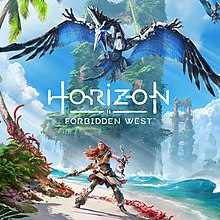

America - Front
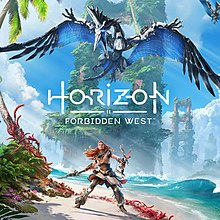

America - Back

Guerrilla Games
Action-Adventure
 02/18/22 Sony Interactive Entertainment
02/18/22 Sony Interactive Entertainment  (Add Date)
(Add Date) 02/18/22 Sony Interactive Entertainment
02/18/22 Sony Interactive Entertainment
| Owners: | 9 | |
| Favorite: | 3 | |
| Tracked: | 0 | |
| Wishlist: | 0 | |
| Now Playing: | 1 | |
Get your crafting benches together and dust off those fast travel kits; the year of the sandbox is officially upon us. Zelda, Elden Ring, Forspoken, Sonic, Starfield, and likely more. And it all kicks off with Horizon: Forbidden West, a sequel to 2017’s Zero Dawn. If it’s possible for a game to go underappreciated while still selling close to ten million copies, Zero Dawn is it, as it had the dubious distinction of launching in the same year as Breath of the Wild. Fortunately, Sony made sure that the sequel will get the spotlight and attention it deserves by… launching it a week before the first open world From Software game. And in the same year as the Breath of the Wild sequel. You have to respect the bravery, if nothing else.
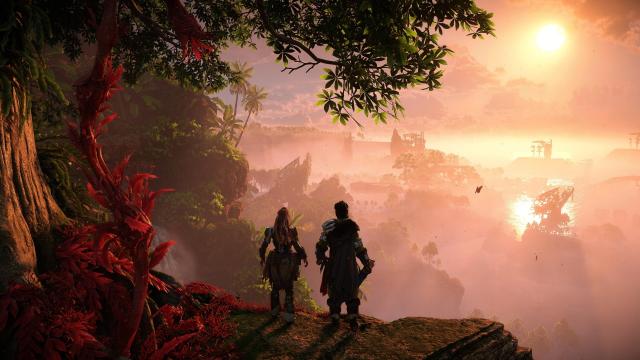
Speaking of brave, Forbidden West once again focuses on Aloy, the Nora Brave and now savior of the world. While I enjoyed Zero Dawn’s story, a lot of that was more for the lore and less the plot and characters themselves. While I’m certainly not about to ding Zero Dawn for not making Aloy asexual or whatever, I do think her character felt a little flat after the well done and presented opening act. While there were moments when you could see Aloy's personality really shine through (like yelling at Sylens), the vast majority of her conversations portrayed a fairly static, stoic character whose traits we were told about far more than actually shown.
Right off the bat, you can tell this is one of the areas Guerilla put a good deal of effort into improving in Zero Dawn. Aloy as a whole feels like a much more engaging character, with a fuller arc that focuses on her overreliance on herself and learning to trust others, as well as Aloy's coming to grips with her new role as a major diplomatic figure rather than just a warrior. We see a character who is starting to crack under the pressure of trying to save the world, and who slowly realizes that her own attempts to brute force her way through every situation with her own skill will inevitably break her. And the best part is that Forbidden West mostly does this without really feeling like the gameplay is taking a back seat to the story, at least outside of the admittedly paced-like-a-slug first hour or so.
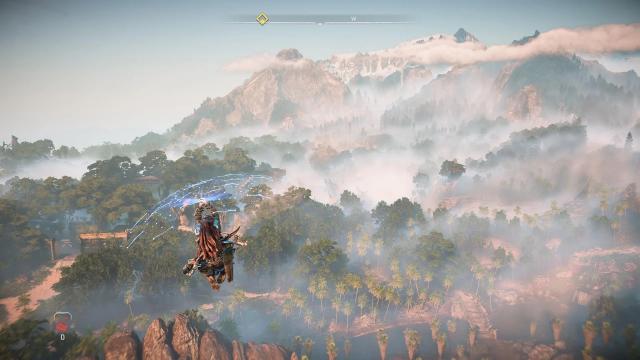
The narrative itself picks up a little while after the previous game’s ending. Turns out that defeating Hades at the end of Zero Dawn didn’t really save the world so much as postpone its collapse, thanks to the absence of Gaia, the AI responsible for maintaining life on post-apocalyptic Earth. Aloy sets off to the “Forbidden West” to attempt to find a backup copy of Gaia with which to keep life going, which of course isn’t going to be as straightforward as that. Along the way, she’ll run into opposition from various inter-warring factions, a new set of extremely dangerous antagonists that in my mind don’t get enough screentime for how intimidating they are, and Aloy’s own tendency to get distracted from saving the world by every random quest to grab 5 machine parts or 10 sets of squirrel intestines for some idiot who can’t be bothered to run their own damn errands.
Gameplay is probably what deserves the closest examination, as there have been a good number of changes since Zero Dawn. One of the things you’ll likely notice right off the bat is how expanded the RPG mechanics are, with a whopping six skill trees rather than the three present in Zero Dawn. Despite the bevvy of new skills, however, I don’t think this is a game where you’ll really be “building” a specific playstyle. Melee and ranged combat both complement each other well, and trying to rely on one exclusively is like trying to have Austria without Hungary, and stealth simply isn’t an option too much of the time to be a practical place to primarily invest points. In short, don’t feel pressure to pick something and stick with it; Aloy functions well with a variety of skills and I think she’s intended to work as such, especially given how liberal the game is with skill points.
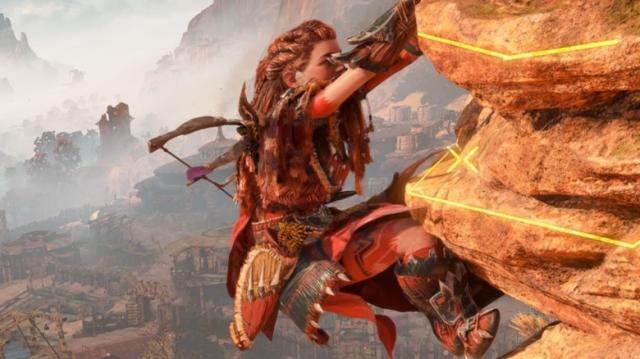
The individual skills certainly flesh out what you could do in the previous game quite a bit. Melee has probably seen the most dramatic improvement overall, now being a fairly substantial hack and slash system. In addition to her standard three hit combo strings, Aloy has aerial attacks, dashing attacks, and jump cancels of all things. Landing a three hit string, jump cancelling it to bypass the usual end-lag of the final swing, and then continuing with an aerial and landing attack is immensely more satisfying than anything melee based in Zero Dawn. It’s kind of a disappointment though that it becomes rather useless against many of the virtually unstaggerable late game enemies that will treat you like a journalist in a Saudi consulate if you attempt to fight them up close.
Ranged combat functions pretty similarly to the prior installment, although there’s a much greater emphasis this time around on status effects. There are far more arrow types and weaknesses for the various enemies in Forbidden West, and making effective use of those is a good way of defeating enemies more quickly. It turns it into a more complex elemental flowchart where you try to take advantage of weaknesses, and I'm not sure I'm a fan of that. Adding a bit of complexity is good, but at the end of the day this mechanic doesn't test much more than your ability to acquire and select the weapon with the poison arrows or whatever. I think the next installment might benefit more from having fewer arrow/elemental weakness types and more unique ways to exploit them on bosses; perhaps hitting a weak point on a boss that's vulnerable to ice ice could allows you to instantly shatter a body part with one melee attack or something. I'm sure professional game designers could do a lot more with this, but ultimately I just wish status effects were more than a game of "hit the enemy with enough arrows that it's weak to and then they get staggered momentarily and/or start to take damage over time."
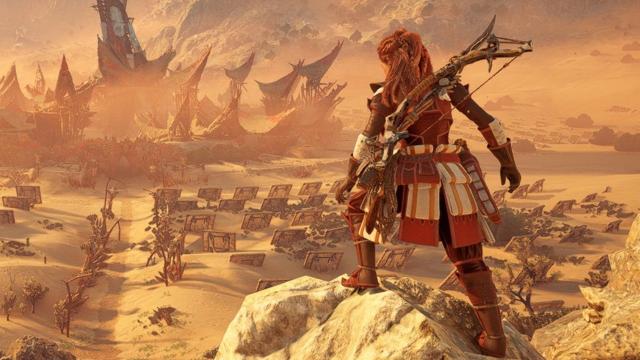
There are a couple of new tools that are briefly worth mentioning, if nothing else. The paraglider that is now endemic to open world games has officially come to Horizon, meaning Aloy can glide and slow her fall from high places. And there’s also a grapple hook, which gives Aloy the ability to grapple onto the contextual button prompts that the game occasionally throws around. Both of these are fine, but don’t really add a whole lot to the experience.
Despite the range of improvements, I still have a couple of quibbles from Zero Dawn that I think still hold over. While I appreciate the attempts to characterize Aloy in gameplay by having her vocalize her thoughts, both Horizon titles have leaned on this lever much too hard for my liking. It’s one thing to do this as a means to develop a character, but something else entirely when it begins to affect gameplay. It’s great that Horizon tries to break up the flow of gameplay with some occasional puzzle solving segments, and absolutely infuriating that Aloy frequently ruins it by vocally spelling out the puzzle solution for me if I don’t solve it within a couple of seconds. At the very least, there should be an option to turn this sort of passive hint system off.
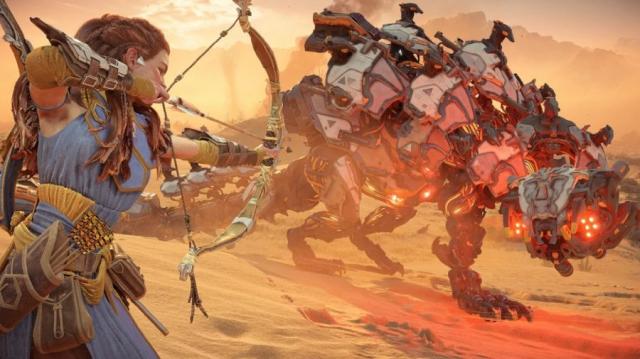
Another frustration that carries over is how inconsistent the world feels at points. What I mean by that is, at certain points, Aloy will make death-defying leaps over a solid ten feet to grab onto a ledge and hang on by a single hand. At other times, jumping off will result in a pathetic little hop that I could probably do better myself. And the only difference between these scenarios is whether there is some sort of “designated climbing point” that is either colored orange or now glows orange on your Focus. The red “stealth grass” that returns is another example of this; you can be buried inside foliage and shrubbery and still get spotted, while being in the “stealth grass” is enough to avoid detection when a machine is right next to you even if your head is obviously poking out.
It makes the world feel less natural, in a way; as if Aloy’s well-honed climbing or sneaking abilities suddenly vanish when she’s not in the presence of the color orange or red respectively. Granted, the alternative extreme of “let people climb anything” comes with its own challenges and drawbacks, and Guerilla may have ultimately decided it wasn’t worth the trade-off. Still, it’s hard for me to feel like climbing in these games is less of a gameplay mechanic and more just a set of glorified contextual button presses, and stealth is not much more advanced than that.
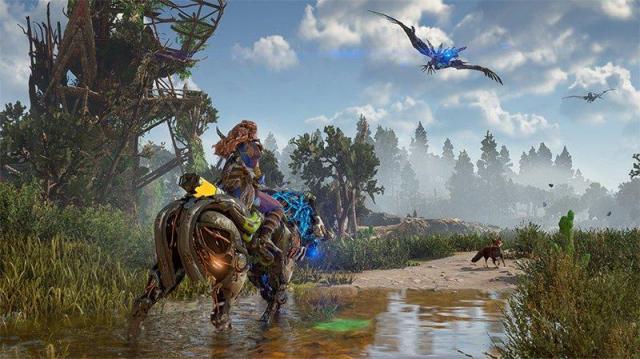
Conversely, side quests have seen improvement; I do like the greater emphasis on getting the story involved and having it relate to the wide variety of supporting characters’ ongoing struggles in some way. It’s a good step up from Zero Dawn’s fetch quest bonanza. While there are still are plenty of quests that do fall into the “collect X amount of items” category, there are also quite a few that go well beyond that. One of my favorites is a not particularly long but nonetheless engaging quest that focuses around a well becoming dried up, and the political tensions that arise. It’s a good example of how much a little story context can add to an otherwise relatively simplistic activity. And there are plenty of other side activities as well, from some contract type missions to melee pits that challenge your skill at close quarters combat.
However, the way that main quests are structured feels like something of a step down. One of the things that Zero Dawn did so well, in my opinion, was to have the story unfold along with each quest. In other words, nearly every main quest the player completed revealed something about the world. There was a mystery in front of us, and Aloy’s goals kept changing as we discovered more about the world with each completed activity. Forbidden West, on the other hand, not so much. The story is structured in a very fetchquest-y way, where our main goal is pretty much set before us at the very beginning and the game simply throws a new barrier in our way every 15 or so minutes. While there’s still plenty to discover about the world, I found myself less enthusiastic about going on story missions this time around, as they were usually just another barricade the game erected to delay me from a previous objective.
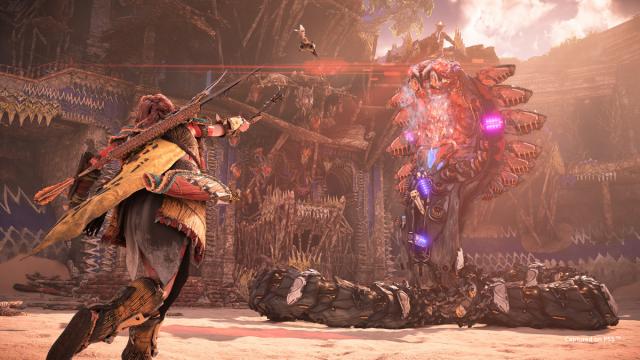
I’ll throw a minor spoiler warning here before giving an example of this. A few hours into the story, Aloy secures a backup copy of Gaia. However, it’s missing three critical subordinate functions, so we need to go hunt those down across the world. To get one of them, we have to talk to Dekka, a local chief, but he refuses to let us have it until we help him. So we volunteer to go with one of his subordinates to try and talk a tribe into lending their military support. But the tribe isn’t interested while they feel like the current conflict poses no risk to them, so we have to blow up their fortress to demonstrate how insufficient their defenses really are and basically coerce them to help. To do THAT, we have to go steal a cannon that’s on top of a boss. It’s a fetch quest with so many layers I genuinely forgot what the main point was by the end of it, and while this is one of the more extreme examples, this sort of fetch quest upon fetch quest design is pretty routine.
Forbidden West is a beautiful game, with some genuinely fantastic art design and character models. Perhaps the biggest aesthetic improvement is having the option to play it at 60 FPS. I’m not sure I could ever go back to playing Horizon at 30; 60 FPS vastly improves the experience and whatever drop in resolution occurs as a result is easily worth it in my opinion. There's a variety of new character designs too that make the various allies and enemies Aloy comes across visually interesting. Some of my personal favorites come from the primary antagonists of the story and the machines at their disposal; without wishing to spoil, the way they move and how different they look from everything else is very visually impressive.
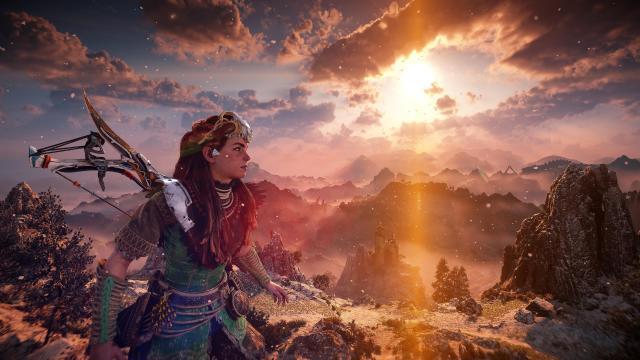
I will say I was slightly disappointed with the biomes on display; much of the territory feels very reminiscent of Zero Dawn. Maybe it's unreasonable to expect a variety of fresh looking terrains in a sequel to a game that had tundras, forests, deserts, plains, and plenty of villages, but at the very least I think I would have liked to have spent a little more time in the ocean/bay environment, which has some truly gorgeous visuals. As it stands, the biome predominantly featured in trailers and marketing is the only one that feels particularly distinct from Zero Dawn, and only the tail end of the story is spent there.
In the midst of a number of popular open world games that seek to reinvent the wheel, Horizon has instead chosen to polish and refine the typical open world format. And that’s not a bad thing at all; while innovation is important, I’d argue iterative improvement is just as important. Titles like Super Mario 64 and Doom may be the most innovative, but without games like Super Mario Galaxy and Doom Eternal we wouldn’t get the chance to see the full potential of those concepts. However, I don’t feel like Horizon is there just yet. It comes close; there’s a lot of stuff here done very, very well, and it's certainly worth a purchase if you're a fan of the genre, but unfortunately it still makes a number of crucial mistakes that narrowly hold it back from greatness.









